Medieval European jewelry underwent remarkable transformations from 500-1500 AD. You’ll discover how Roman techniques evolved into Germanic tribal styles, followed by Byzantine religious symbolism and opulent gemstones. The Romanesque period introduced vibrant enameling, while Gothic craftsmen perfected gemstone cutting. Goldsmith guilds standardized quality through hallmarking, and royal courts elevated jewelry from mere adornment to status symbols. These seven evolutionary stages reveal how medieval jewelers mastered both artistic expression and technical innovation.
7 Best Medieval European Jewelry Transformations Over Time
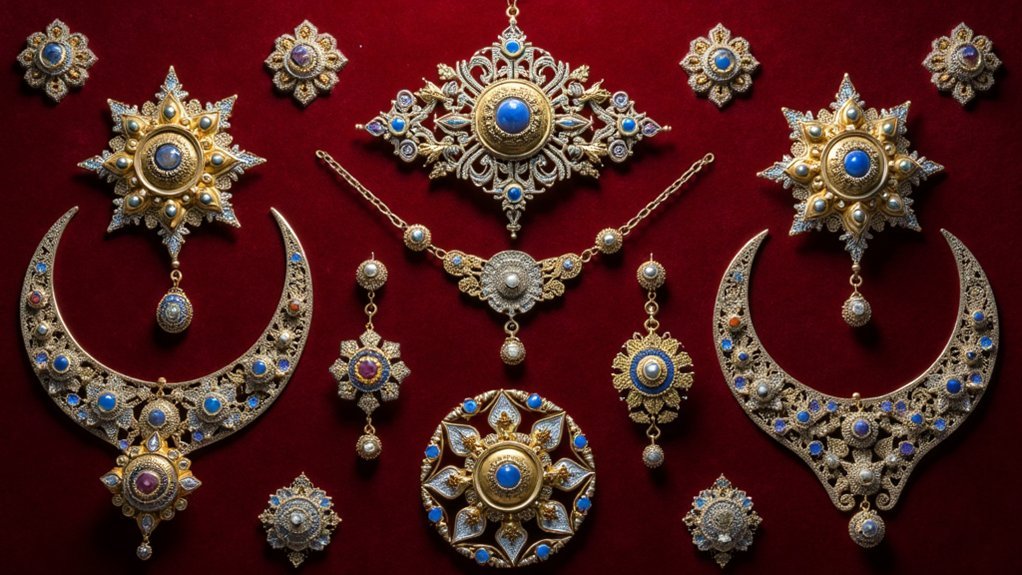
While we often think of medieval times as the “Dark Ages,” the jewelry craftsmanship of this era tells a dramatically different story. European jewelry designs evolved dramatically from the Migration Period’s bold Germanic styles to the Gothic Period’s intricate religious symbolism over a thousand years.
The medieval period witnessed revolutionary advances in metalworking techniques. The 12th century’s guild system fostered knowledge sharing among goldsmiths, elevating craftsmanship standards. You’ll find this technological innovation evident in the introduction of sophisticated enameling methods like cloisonné and champlevé, which brought vibrant colors to previously monochromatic pieces.
Perhaps most transformative was the late 14th century development of gem cutting. This advancement replaced simple cabochon styles with faceted precious gemstones, culminating in the 1471 table cut for diamonds—a breakthrough that foreshadowed Renaissance luxury and modern jewelry design principles.
From Roman Remnants to Germanic Tribal Adornments (500-700 AD)
As the curtain fell on the Western Roman Empire, the jewelry landscape of Europe underwent a remarkable metamorphosis. You’d find Germanic tribes adopting Roman techniques while infusing their own artistic sensibilities, creating a rich cultural tapestry that would define early medieval Europe.
| Jewelry Styles | Cultural Significance |
|---|---|
| Gold and silver filigree | Status and wealth markers |
| Animal motif adornments | Tribal identity expression |
| Christian symbol pieces | Religious conversion evidence |
While the Byzantine Empire maintained classical elegance, Germanic craftsmen developed bolder designs featuring precious stones and intricate metalwork. Their burial artifacts reveal how jewelry transcended mere decoration, becoming powerful social communicators. Christianity’s spread introduced crosses and religious imagery, while traditional techniques like granulation preserved Roman craftsmanship legacy—transforming adornment practices that would influence jewelry design for centuries to come.
Byzantine Opulence and Religious Symbolism (700-900 AD)

When the Byzantine Empire reached its cultural zenith between 700-900 AD, jewelry transformed into spectacular displays of imperial wealth and Christian devotion.
You’ll find that Byzantine artisans mastered techniques like granulation and cloisonné enamel, creating opulent jewelry adorned with sapphires and emeralds that showcased the empire’s prosperity.
Religious motifs dominated these pieces, with crosses, saints, and icons serving both decorative and spiritual purposes.
Beyond faith, intricate designs incorporated animals, plants, and mythological figures that conveyed deeper ethical meanings. This sophisticated symbolism reflected the complex cultural narratives of Byzantine society.
The influence of these dazzling creations didn’t stay contained within imperial borders.
As trade routes expanded, Byzantine jewelry techniques and aesthetic sensibilities gradually transformed adornment traditions throughout Western Europe, particularly in Italy and France.
The Romanesque Revolution in Goldsmithing (900-1200 AD)
During the Romanesque period from 900-1200 AD, European jewelry underwent a revolutionary transformation that redefined the goldsmith’s craft. You’ll find this era introduced vibrant cloisonné enamel techniques, allowing for unprecedented color combinations in jewelry designs. Monasteries became central hubs where goldsmiths created ecclesiastical pieces with intricate religious motifs.
| Jewelry Type | Function | Cultural Significance |
|---|---|---|
| Brooches | Decorative fasteners | Displayed wealth and artistic taste |
| Signet Rings | Document sealing | Reflected family status and authority |
| Pendants | Religious display | Conveyed spiritual devotion |
| Ecclesiastical items | Ritual purposes | Demonstrated monastic craftsmanship |
The emerging guild system regulated goldsmithing standards while new jewelry forms showcased gemstones with both status and spiritual significance. Romanesque goldsmithing truly bridged functional necessity with artistic expression in medieval Europe.
Gothic Elegance and the Rise of Gemstone Cutting (1200-1400 AD)

The Gothic period transformed European jewelry from 1200-1400 AD, elevating it beyond mere adornment to a sophisticated art form.
You’ll find this era marked by intricate metalwork and revolutionary enamel techniques like emaille en ronde bosse that enhanced each piece’s visual appeal.
Three key innovations defined Gothic jewelry:
- The evolution of gemstone cutting from simple cabochons to table cuts, dramatically increasing brilliance.
- The incorporation of natural forms and motifs reflecting broader cultural movements.
- The establishment of urban guilds that facilitated technique sharing among artisans.
Germanic inlay work exemplifies the technical mastery achieved during this period.
As urban centers flourished, jewelry craftsmanship became more refined, with artisans collaborating to produce pieces of unprecedented quality and artistic complexity.
Guild Systems and the Standardization of Craftsmanship (1100-1500 AD)
You’ll find the medieval goldsmith guilds, emerging in the late 11th century, created hierarchical structures that transformed jewelry production from individual craftsmanship to regulated collective enterprise.
These powerful associations established strict quality control measures, including the revolutionary hallmarking system that required artisans to stamp their work with symbols indicating metal purity.
Through these standardized practices, guilds effectively guaranteed craftsmanship excellence while building consumer trust across Europe’s marketplaces.
Goldsmith Guild Structure
As European towns grew in prosperity throughout the late 11th century, goldsmiths began organizing themselves into formal guild structures that would fundamentally reshape jewelry production for centuries to come.
These guilds established strict quality standards and created a framework for innovation that elevated medieval jewelry craftsmanship to unprecedented levels.
Within the hierarchical structure, you’d find:
- Master Goldsmiths – Elite artisans who owned workshops, trained apprentices, and upheld the guild’s reputation
- Journeymen – Skilled craftsmen who’d completed apprenticeships but hadn’t yet achieved master status
- Apprentices – Young trainees bound to a master for 5-7 years, learning techniques from basic metalwork to advanced gem setting
Guild regulations standardized gold purity and manufacturing techniques, while simultaneously facilitating the exchange of innovations like cloisonné enamel across European borders.
Quality Control Measures
During this transformative period of European craftsmanship, medieval jewelry guilds established rigorous quality control systems that revolutionized production standards across the continent. You’d find these goldsmiths operating under strict standards, with Paris mandating impressive 19.2 karat gold purity that guilds vigorously enforced.
| Guild Contribution | Impact | Legacy |
|---|---|---|
| Thorough apprenticeships | Preserved techniques | Guaranteed craftsmanship excellence |
| Material standards | Consistent quality | Built consumer trust |
| Collaborative innovation | Advanced techniques | Developed cloisonné and enameling |
These organized systems didn’t just regulate techniques—they transformed how knowledge transferred between generations. Through structured apprenticeships, aspiring goldsmiths learned directly from masters, while guilds facilitated communication that sparked innovations. This standardization across regions meant you’d receive jewelry of reliable quality regardless of where it was crafted.
Royal Court Influences on Medieval Jewelry Design (1300-1500 AD)
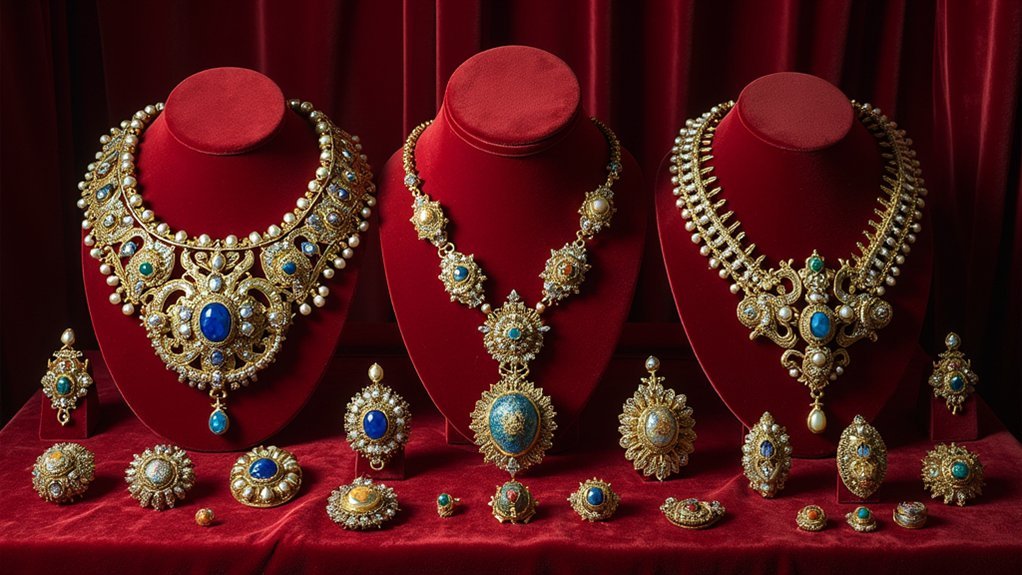
The opulent halls of European royal courts between 1300-1500 AD sparked a revolution in jewelry craftsmanship that would define medieval aesthetic for centuries.
You’ll find that royal patronage transformed jewelry from mere adornment to powerful symbols of status, with intricate metalwork and luxurious materials like gold and gemstones reserved exclusively for nobility through strict sumptuary laws.
- Gothic designs flourished under royal influence, featuring natural forms and innovative gem-cutting techniques that demonstrated both wealth and artistic sophistication.
- New enamel methods including cloisonné and champlevé emerged from royal workshops, adding vibrant color palettes previously unseen in medieval jewelry.
- Distinctive heraldic motifs became prevalent in elite jewelry, visually communicating family lineage and political alliances through carefully crafted symbols.
Frequently Asked Questions
How Has Jewelry Evolved Over Time?
You’ll notice jewelry has evolved from primitive adornments to sophisticated designs. It’s transformed through improved techniques, cultural exchanges, materials accessibility, and societal values, constantly reflecting the artistic capabilities of each civilization.
What Jewelry Was Worn in Medieval Times?
You’d have found medieval people adorning themselves with gold and silver brooches, signet rings bearing family crests, and gemstone necklaces. Ecclesiastical jewelry like papal rings also showcased exceptional craftsmanship during this period.
What Techniques Were Used in Medieval Jewelry Making?
You’ll find medieval jewelers used lost-wax casting for 3D forms, enameling techniques like cloisonné and champlevé, and cabochon polishing for gemstones. They worked under guild regulations with high-purity gold and silver standards.
What Are the Oldest Forms of Jewelry?
The oldest forms of jewelry you’ll find date back to the Upper Paleolithic period. You’re looking at simple adornments made from shells, bones, and stones that people wore for decoration and protection.
In Summary
Across these medieval transformations, you’ve seen how European jewelry evolved from Roman influences to sophisticated court designs. You’ll recognize that religious symbolism, technical innovations, and guild standards played essential roles in this evolution. As you explore medieval jewelry collections today, you’re witnessing the remarkable journey of craftsmanship that reflects Europe’s changing cultural, political, and spiritual landscapes over a thousand years.

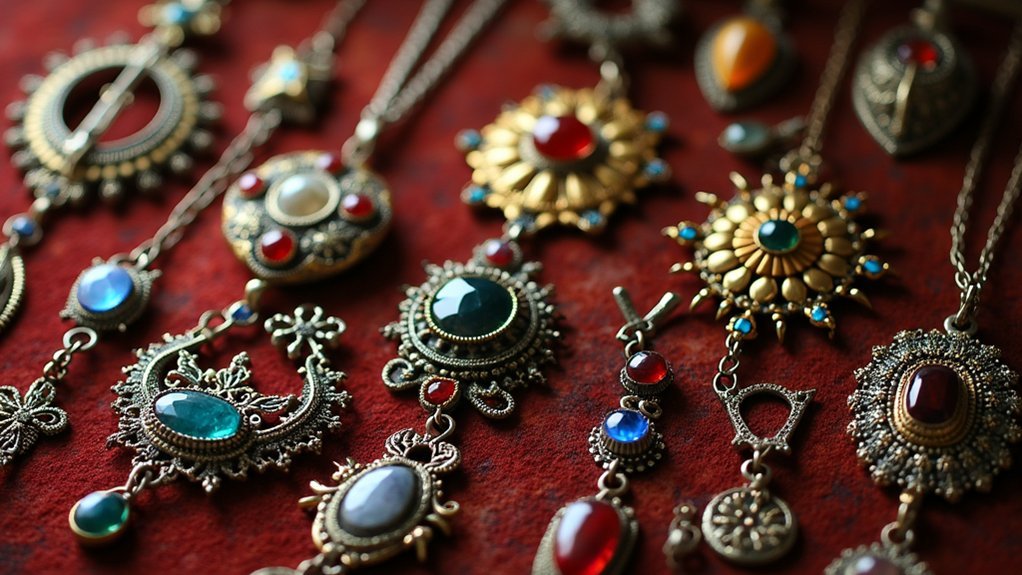
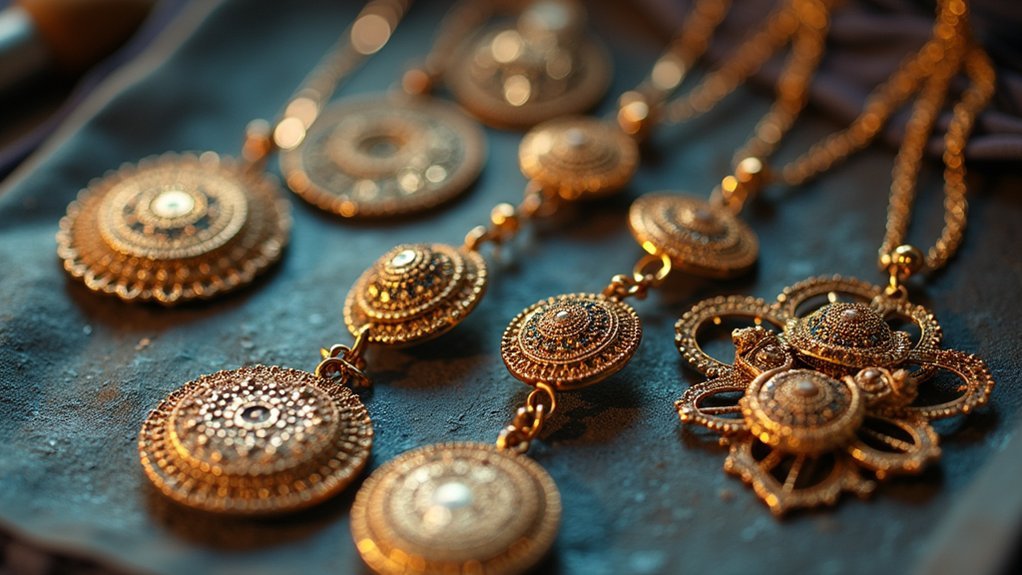
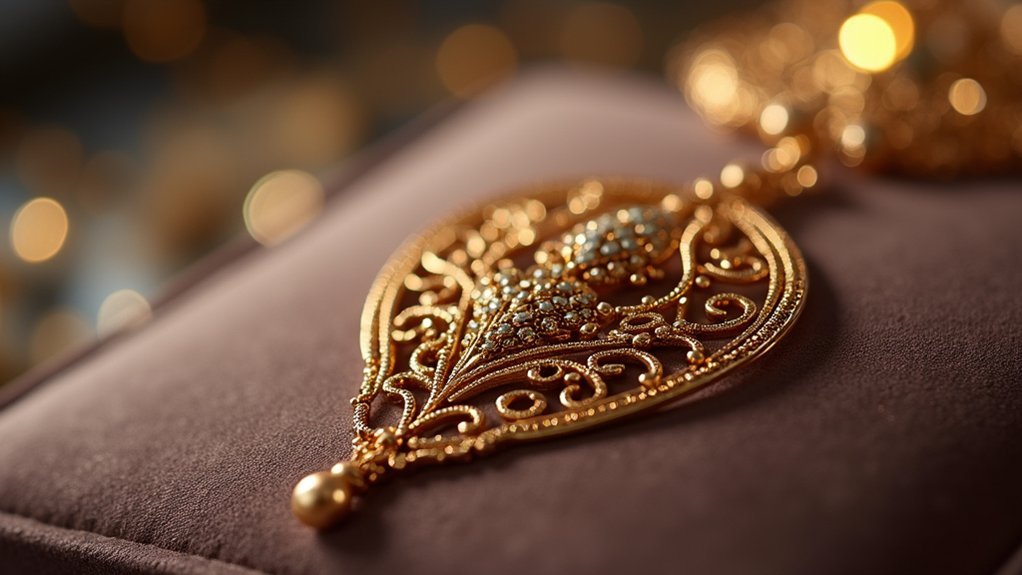

Leave a Reply